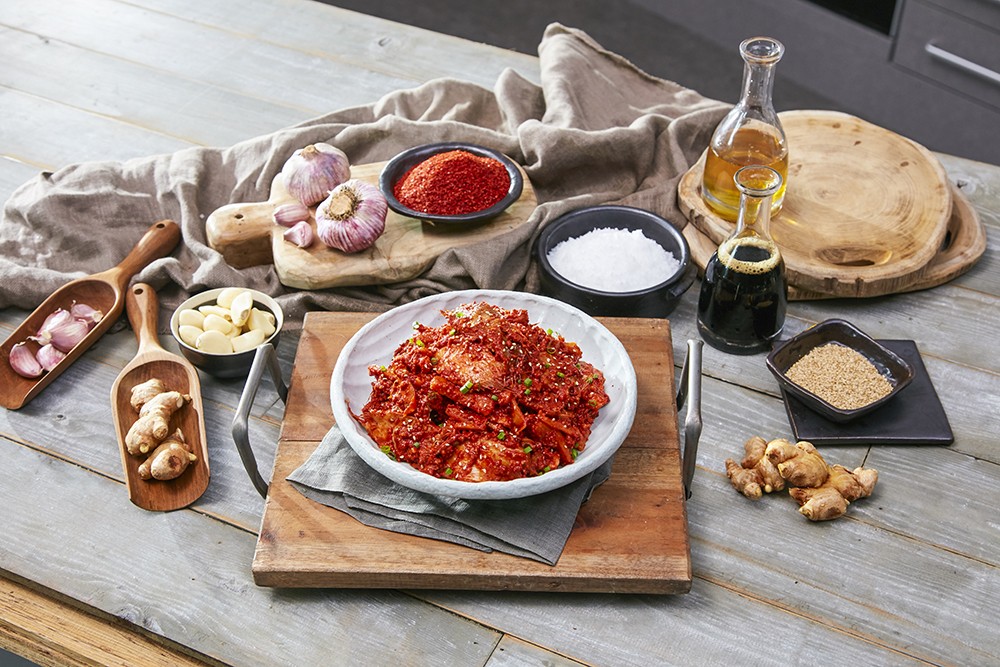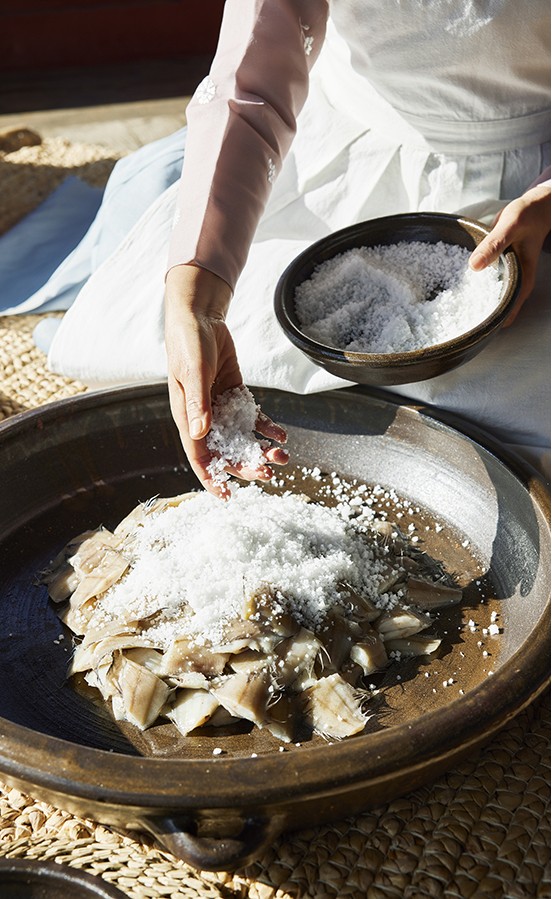한식 읽기 좋은 날
Vol 58. Fermentation and Jeotgal
Fermenting Ingredients from Land and Sea: Sikhae
The Wisdom of HANSIK
Most people, Koreans and foreigners alike, are familiar with sikhye (sweet rice punch), but not the similarly-pronounced and spelled "sikhae". The difference is in the second character: "hye" means "vinegar," while that for sikhae (醢) means "jeotgal." Why, then, do we need to distinguish between sikhae and jeotgal?
Article Lee Hyunju (Editorial Team) Sources “Characteristics of Jeotgal, a Traditional Fermented Food” (Article collection of Industrial Technology Center, Honam University; 2011), Korean Everyday History as Seen Through Food (Yoon Deokno, 2014)

Ⓒ Sunho Food
Jeotgal with rice
The biggest difference between jeotgal and sikhae is the latter’s inclusion of rice. The next question is usually why rice is used at all—the answer to which can be found in sikhae’s place of origin. It was consumed mostly as a side dish in the eastern coastal regions of Hamgyeong-do (currently, part of North Korea), Gangwon-do, and the Gyeongsang provinces. Contrary to the western coast, salt was difficult to obtain on the eastern coast. This shortage eventually led to the invention of low-salt jeotgal.
Sikhae ingredients include virtually every kind of seafood available in Korea. Traditionally, it is made with fish (e.g. halibut, pollack, cutlassfish, cod, flounder, sailfin sandfish, anchovies), mollusks (e.g. conches, octopus, squid, clams), or fish parts (e.g. pollack gills/offal/roe).
Sikhae is made by first mixing the main (fish) ingredient with radish, pepper flakes, and salt, after which malt and rice are added. The rice is almost always made with millet, a practice that was especially common in Hamgyeong-do, with differences among regions in terms of whether glutinous or non-glutinous rice was used. During kimjang season, sikhae was made alongside kimchi. In the eastern coastal regions, sikhae was sometimes added to/mixed with kimchi or consumed as a kimchi substitute.
The first mention of sikhae in historical documents is found in Sangayorok, a cookbook published in 1459. The book refers to “eohae” and describes how it is made in detail (“Fish is cured with salt. After partially filling a jar with non-glutinous rice, the cured fish is inserted into the rice. When all of the fish has been put inside the jar, the top is pressed down by hand.”). Experts believe that actual sikhae consumption began before the 1400s.
Countries such as Myanmar, Thailand, and Laos, which, like Korea, have a rice-based diet, have foods that are similar in principle to sikhae. What these countries have in common is that, due to their tropical climate, fish and salt were always in short supply. It was thus only logical to use as little salt as possible to ferment the fish.

The profound flavor that remains after the rice is gone
Jeotgal that is sufficiently fermented does not have an unpleasant smell (e.g. fishy or like ammonia/sulfur). The protein in fish is easy to digest and easily absorbed because it can be broken down into peptides and amino acids (e.g. lysine, glutamic acid, glycine, alanine, and leucine). The secret to jeotgal’s savory flavor and distinct fragrance is betaine, trimethylamine N-oxide, and nucleic acid.
Depending on the type of sikhae, rice grains may remain or have been completely dissolved during fermentation, with the latter being difficult to tell apart from jeotgal. The easiest way to distinguish the two is by the taste: unlike jeotgal, sikhae is sweet and sour. It may have a lower salinity, but lactic acid fermentation also lowers the pH, resulting in repressed saprogenic bacteria production and a unique fragrance and flavor. Simply put, malt-mixed rice saccharizes and undergoes fermentation, which, over time, produces a sweet and sour taste that is polarizing but undeniably something that sets sikhae apart from other foods.
In premodern Korea, the typical Korean diet was comprised of rice and vegetables. The lack of protein was made up for with fish, in the format of jeotgal or sikhae, because it was relatively easier for the commoner class to obtain than meat. Sikhae has the dual advantage of being easy to make and rich in minerals and water-soluble vitamins (e.g. amino acids, sodium, calcium, iron, phosphorus), making it easy to digest. In the Joseon dynasty, sikhae was served during royal ancestral rituals at Jongmyo Shrine. Although it is not as widely available as jeotgal, if you ever come across the opportunity to try sikhae, please take advantage of it!

 한국어
한국어
 English
English






